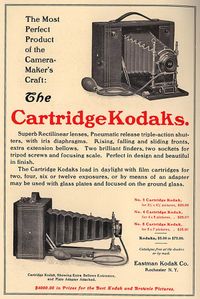Cartridge Kodak cameras
The name “Cartridge Kodak” was inspired by the resemblance between a rolled film spool and a cartridge—such as a shotgun shell. The similarity goes beyond appearance alone: cartridges of any kind are designed to be inserted and removed quickly and easily. When the Cartridge Kodak was introduced in 1897, the daylight roll-film spool represented an important innovation over earlier film rolls, which had to be loaded into the camera inside a darkroom. The word “Cartridge” thus emphasized how simply and swiftly the camera could be loaded. This became one of the defining features of the Cartridge Kodaks: they were cameras designed for daylight loading.
Another characteristic of these cameras was their collapsible bellows and retractable lens tube. The combination of these two features, together with the typical shape of the Cartridge Kodaks, resulted in a relatively flat, horizontally oriented box camera, with the lens positioned at the center and able to fold back into the body along with the bellows. On either side of the bellows were compartments for the supply and take-up spools. This design marked a clear departure from earlier bellows cameras for roll film. In previous Folding Kodaks, both spools were arranged behind the image plane, resulting in bulkier cameras.
1902 ad
The Cartridge Kodaks were made in three sizes:
- No. 3: 3 1/4 x 4 1/4 inch
- No. 4: 4 x 5 inch
- No. 5: 5 x 7 inch
All three had the same design, with rising and sliding front panel and interchangeable film and plate backs. They were well suited for taking a snap shot, using the little reflex finders and the distance scale to set the proper distance. But they also could be used for more "serious" picture taking. The rising and sliding front was used to avoid perspective distortion. The plate back with ground glass was used to focus the instrument more precisely and to judge the composition of the image.

